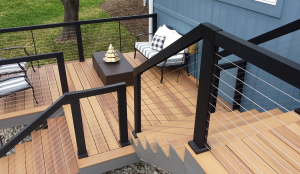Railing Materials and Durability: Exploring the Strength of Carbon Fiber, Aluminum, and Composites
When it comes to designing and constructing railings, the choice of materials plays a crucial role in determining not only the aesthetic appeal but also the long-term durability and maintenance requirements. Traditional materials like wood and steel have been widely used, but advancements in technology have introduced a new era of railing materials that offer superior strength, low maintenance, and long-lasting durability. In this article, we will delve into the world of advanced materials such as carbon fiber, aluminum, and composites, exploring their properties and the benefits they bring to railing systems.

Carbon Fiber: The Pinnacle of Strength and Lightness
Carbon fiber is a high-performance material known for its exceptional strength-to-weight ratio. While traditionally associated with aerospace and automotive industries, carbon fiber has found its way into architectural applications, including railing systems. Carbon fiber railings offer unparalleled strength, making them an excellent choice for high-stress environments.
The unique combination of strength and lightness in carbon fiber railings ensures structural integrity without adding unnecessary weight. This not only enhances the overall durability but also simplifies installation and maintenance. Additionally, carbon fiber exhibits excellent corrosion resistance, ensuring a prolonged lifespan in various weather conditions.
Aluminum: The Versatile Lightweight Option
Aluminum has long been recognized for its versatility and corrosion resistance. In recent years, it has gained popularity as a preferred material for railing systems due to its lightweight nature and durability. Unlike steel, aluminum does not corrode, making it an ideal choice for outdoor applications where exposure to the elements is a concern.
One of the key advantages of aluminum railings is their low maintenance requirements. They do not require regular painting or coating to protect against rust, contributing to long-term cost savings. Additionally, aluminum railings can be easily customized to meet specific design preferences, offering architects and builders a wide range of options.
Composites: Blending Strength and Aesthetics
Composite materials, typically a combination of two or more different substances, have gained popularity in various industries for their ability to combine the best properties of each component. In railing systems, composite materials often consist of a mix of polymers and fibers, such as fiberglass or carbon fiber.
Composite railings offer the strength of traditional materials with the added benefits of low maintenance and resistance to weathering. They are resistant to rot, insects, and UV rays, ensuring a longer lifespan compared to traditional wood railings. Furthermore, composites provide architects and designers with the flexibility to achieve a wide range of aesthetic styles, mimicking the look of wood or adopting a sleek modern appearance.
As the construction industry continues to embrace innovation, the use of advanced materials in railing systems has become increasingly prevalent. Carbon fiber, aluminum, and composites represent a new frontier in railing design, offering high strength, low maintenance, and long-term durability. These materials not only enhance the structural integrity of railings but also provide architects and builders with versatile options to meet both functional and aesthetic requirements. As technology advances, we can expect even more exciting developments in railing materials, further shaping the future of architectural design.

 +86 159 6420 9667
+86 159 6420 9667  sales@haxrailing.com
sales@haxrailing.com 



